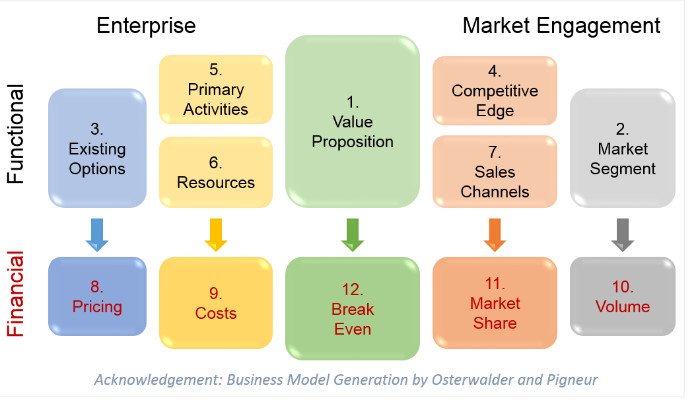Business Blueprint Simplified – Part 1 – New Business Line
Startup, small, medium, or large: what-ever size your business may be, chances are you are looking to convert new ideas into monetary gains. Number of questions with equally large number of choices cross your mind.
Here is how you can put all that on a one page landscape and qualify it for pursuit. Refer to the graphic and fill in the 12 boxes in the sequence as numbered. At this point, do not worry about the relative placement of these boxes. Yes, you will hop around, and that is for a good reason, which you will understand by the end of this short article.
A 12-box 1-page Business Blueprint
1. What is your value proposition?
Product: New product, new capability, a new core technology, established product adapted to a new market, better look and feel, cheaper alternative,…
Service: physical, intellectual, emotional, entertainment, logistics, healthcare, transport, financial, security, online, emergency response,…
2. What market segments are you going after?
Types: Mass market, niche market, specific customer(s), segmented & diversified, multi-sided platform, …
3. What are existing options with the customers today?
No option: you are defining a need, creating value, you can set price for high profits
Few options: perhaps barrier to entry is high, with opportunity for profits, when value is demonstrated
Many options: barrier to entry is low, and so will be the profits. Watch out!
4. What is your competitive edge?
Potential – Talent, knowledge, assets, IP, existing product line, …
Excellence in execution – cost structure, speed, logistics, locations, …
Image – Branding, public relations, Govt relations,
5. Primary activities do you need to undertake for this venture?
Design, development, prototype, manufacturing, supply chain, aftermarket, financing, training, recruitment, resource acquisition, safety/regulatory compliance, …
6. What is your resource requirement?
People, facilities, equipment, IT infrastructure, IP, finances, reserves, …
7. What sales channels would you be using?
Physical stores, virtual stores, partner stores, personal network, vending machines, trade shows, conferences, door to door, kiosks, …
8. What is your pricing model?
Deterministic – Fixed, cost + profit, Freemium, insurance
Opportunistic – Negotiable, yield driven, perishables, auctions, performance based
Your answers in box 3 (existing options) determine the max you can charge.
9. What are your costs?
One-time costs, fixed costs, units costs, economies of scale, value driven costs, negotiable costs, …
Your answers in box 5 & 6 (activities and resources) determine the minimum you can achieve.
10. How much capacity does market have for your offering?
Millions (Mass market), Thousands (Niche market), Tens (specific customer),
Your answers in box 2 determine the best you can hope for
11. What market share do you hope to capture?
What % age during launch period, growth period, mature stage… and How – Lease/Sales/Subscription
Your answers in box 4 & 7 (competitive edge and sales channel) determine the maximum you can capture.
12. When will you break even ?
Now you can calculate the time frame and sales quantity required to start making profits.
Your answers to box 9 & 11 will help you estimate your break-even point
End Game
We started with a value proposition in Box 1 and end up with break-even point, just below, in Box 12.
The boxes on the left are the enterprise side and right side is about engaging with the market.
The upper row of boxes is all about functional or execution and lower row is all about financial aspects.
Each financial box is primarily related to the functional boxes just above.
If you are not satisfied with the break-even point, and it does not make proper business case, think about where in the upper row you can make changes to adjust the equation in the lower row. You may end up going all the way back to redefining your value proposition.
You balance this out, you are good to start THE new business line…..
Acknowledgement: The underlying philosophy for this model is based on the Book – “Business Model Generation” by Alexander Osterwalder and Yves Pigneur.

